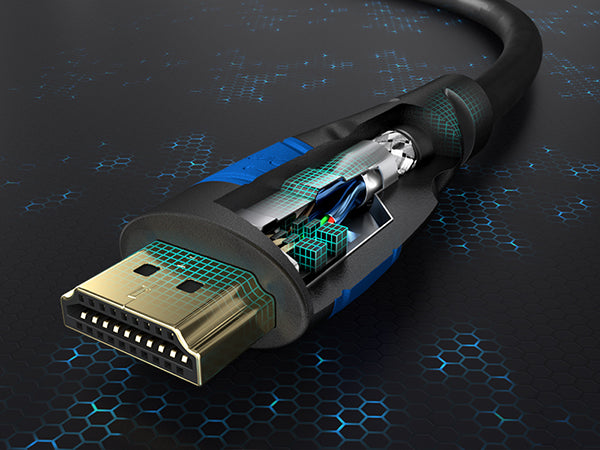
1.4, 2.0, 2.1? DEMYSTIFIYING HDMI VERSIONS
Share

HDMI cables may all look the same, but behind the scenes it’s a different story. There are in fact several versions of the universal multimedia interface through which video and audio signals are fed to many monitors and practically all TVs. But how do they differ? Read on to learn more.
Since the start of 2021, KabelDirekt’s range has included one of the first certified “Ultra High Speed” HDMI cables. This class of cable is defined in version 2.1 of the HDMI specification, which replaces versions 2.0 and 1.4. Nevertheless, not every HDMI 2.1-compliant cable is the same – that’s because this version number alone says nothing about what features a cable or device supports. Yep, it’s complicated.
A brief history of HDMI
In 2002 an international consortium developed the High Definition Multimedia Interface. The aim was to replace outdated video and audio connectors, such as DVI, component video, and SCART, with a universal connector that is digital, versatile, and capable of handling high resolutions. Version 1.0 supported the Full HD resolution of 1920×1080 and defined a single connector type – type A – which is still in use today. But it soon became clear that this standard could no longer keep pace with technology’s onward march.
Later versions of the HDMI specification added new features and connectors – including the Mini HDMI connector for portable devices, which was introduced with version 1.3. At the same time, the maximum bit rate increased to provide support for resolutions of up to 2560x1440. Version 1.4 added further enhancements, including support for 3D video signals and the optional Ethernet channel for network data. Last but not least, the latest version 2.1 of the standard added support for ultra-high resolutions of up to 8K (7680×4320). See here for more about this standard and its many features.
Yet despite all this, the actual version number of the HDMI standard doesn’t reveal that much.
One standard – lots of options
Most of the features and resolutions added to the HDMI standard over the years are optional. Each HDMI version is simply a list of possible features that a manufacturer might or might not implement for its particular item of equipment or device.
This is because not every Blu-ray player with an HDMI 1.4 output also has a need for Ethernet functionality – even though it is theoretically possible; not every HDMI 2.0-compliant TV supports 3D signals; and a monitor without built-in speakers obviously won’t need advanced surround sound features that the HDMI standard would allow.
So: Always pay attention to exactly which features are meant when a manufacturer advertises the “HDMI 2.1” compatibility of its equipment or devices.

From Standard to Ultra – a cable to suit any requirement
Which of the many HDMI features – from multi-channel audio to 8K video – an HDMI cable supports depends on its bandwidth – or in other words its maximum data transmission speed. In turn, you can’t tell this from the version number alone – you’ll need to check the separate cable classification. Since HDMI 1.3, cables have been classified into two categories – “Standard” and “High Speed” – with version 2.1 adding “Ultra High Speed” cables.
“Standard” cables are only fine for low 720p resolutions; however, since they’re now obsolete, all KabelDirekt cables meet or surpass the higher “High Speed” class – which is fast enough for 4K video. The new “Ultra High Speed” cables also support extremely high 8K resolutions plus the many features that HDMI 2.1 introduced, from ALLM to VRR, yet even the classification “HDMI 2.1 cable” is unclear.
That’s because this latest HDMI standard still includes the older “High Speed” and even “Standard” classes, with the former still perfectly adequate for many TVs, monitors, and projectors. Ultimately, this means that not every “HDMI 2.1” cable necessarily supports 8K. What you really need to be looking out for is the classification “Ultra High Speed”. The only cables that can carry this label are those certified by the HDMI consortium, which guarantees they meet the highest standards.

